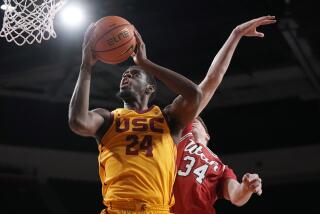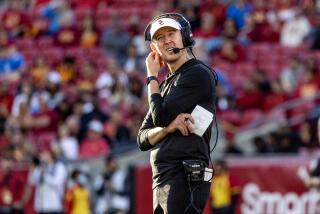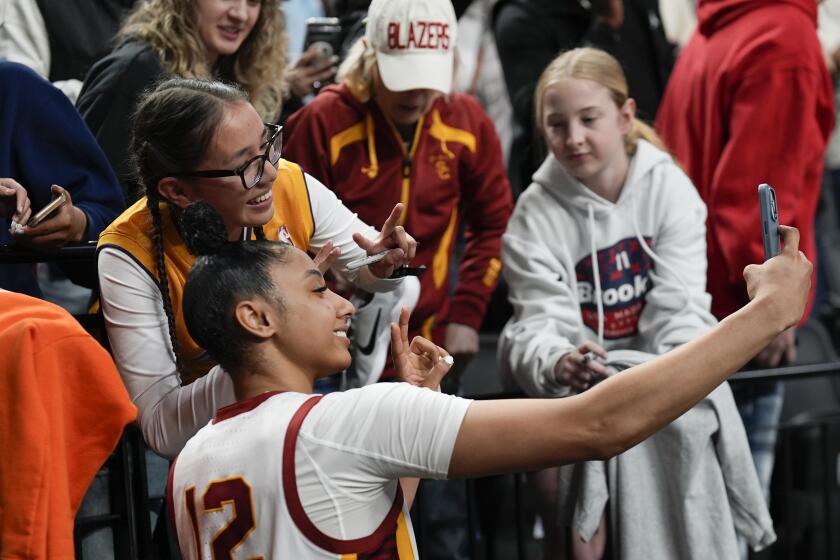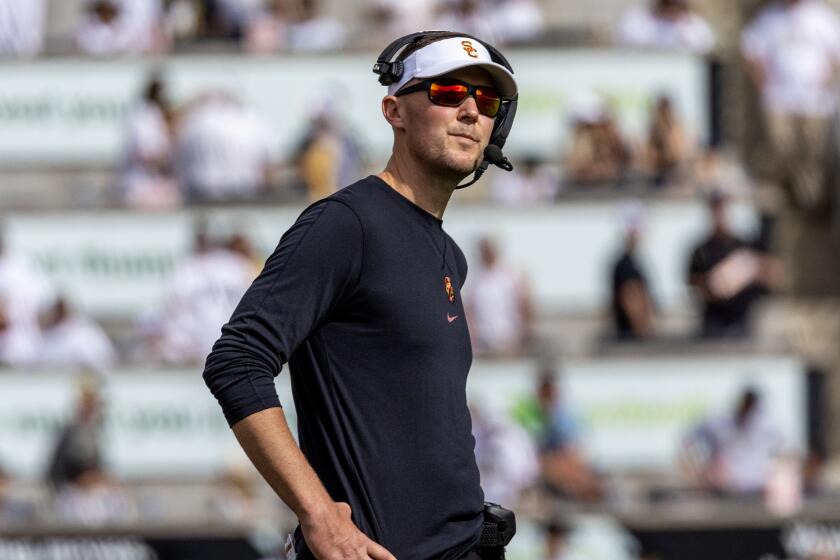Sam Darnold’s ascension to starting quarterback is a big reason USC has turned season around
In a cramped room under Utah’s Rice-Eccles Stadium, bundled in a puffy red raincoat, USC football Coach Clay Helton offered an unusual declaration.
“I can’t tell you how proud I am of the kids that are in that [locker] room and the performance that they just gave,” Helton said.
It was a strange choice of words. USC had just suffered its most painful defeat of the season, a come-from-ahead collapse to Utah in the final minute.
If Helton regretted the phrasing, he didn’t show it two days later. Sitting just off USC’s campus for his weekly radio appearance, he smiled recounting the game.
“I walked off that field, that was the most fun I’ve had in a long time,” Helton said.
For many USC fans, the quote was jarring, out of step with reality. Fun? The Trojans, owners of a 1-3 record, had sunk to depths they don’t typically plumb.
Almost a month later, they have not lost since.
The Trojans’ season has developed like a photograph rendered next to its negative. It can be divided into two distinct eras: Before Darnold and After Darnold. Helton’s decision to insert Sam Darnold at starting quarterback, replacing the popular and capable Max Browne, has altered USC’s trajectory.
USC has improved markedly in almost every significant statistical category since Darnold became the starter. Not all of it can be credited to him, but it marked the beginning of a surge. It began against Utah. Three turnovers and a surprisingly porous defense late cost USC the win, but Helton had caught a glimpse of a bright future.
“As a coach, you’ve been in it 20 years,” Helton explained recently. “They haven’t. And you see a team that goes to Utah, the way they prepared, the way they went into that hostile atmosphere and performed and came 16 seconds away, you’re like, ‘Wow, OK, there moving in the right direction. Now let’s don’t lose that momentum.’ ”
Here’s what has changed:
Offense
The difference wrought by Darnold has been dramatic.
He also stepped into a more stable situation than he would’ve had he started the opener against Alabama.
“I don’t think we were comfortable yet with our team,” tight end Tyler Petite said. “You have a brand new coaching staff, a brand new way of doing things. We had a little bit of unrest that was settled with Coach Helton, and now it’s getting back to getting really comfortable.”
Darnold’s impact has nonetheless been undeniable. In USC’s first three games, the team averaged 3.6 rushing yards per attempt. That boomed to 5.8 in the next four. Its 5.6 yards per throw jumped to 9.2.
The turnaround is so dramatic, in part, because USC’s start was so feckless. And an easier schedule helped.
But the schedule alone doesn’t fully account for the change. Since Darnold became the starter, USC has surpassed, often dramatically, the average yards typically allowed by its opponents. (The same has held true for USC’s defense.)
The offensive style, too, underwent a dramatic shift. Colorado Coach Mike MacIntyre remarked that USC had become a spread team.
“The best thing is just knowing the quarterback,” Trojans offensive coordinator Tee Martin said. “Earlier in the year it was two quarterbacks. And once we announced who the quarterback was going to be, it was, ‘OK, what is he like?’ You have to call plays as if you’re him.”
Now, Martin said, “We’re kind of getting into a nice rhythm.”
The same could be said of USC’s best offensive weapons.
JuJu Smith-Schuster’s receiving yards jumped by about 84 yards per game with Darnold throwing to him.
And Justin Davis’ yards per carry have skyrocketed in that span, from 3.6 to 9.2. (He missed the last game with a high ankle sprain).
Only one troubling habit has emerged: USC has seven turnovers in the last four games, up from three in the first three games.
Defense
Stuck with a defense that was anything but disruptive, Helton and defensive coordinator Clancy Pendergast held a meeting. Helton said he told Pendergast he had to find more ways to bring pressure. Pendergast agreed.
USC went from zero sacks against Stanford and Utah to three against Arizona State, then four in a punishing performance against Colorado.
Like the offense, USC’s defense has improved from a middling unit to an efficient one. Its 5.0 rushing yards allowed per carry in the first three games improved to 3.7 in the next four. It shrunk its passing yards per attempt from 7.4 to 4.9.
“The pressure that’s getting to the quarterback is the thing you see the most,” Helton said.
Cornerback Adoree’ Jackson implied that the transition to a new coaching staff also played a role on defense.
Now, he said, “we’re more playing as a team. Just knowing that person next to us is going to do his job.”
Earlier in the season, the defense wasn’t as confident in Pendergast’s new 5-2 scheme.
“The guys feel more comfortable in the system the more they play together,” Pendergast said.
Last week’s game at Arizona provided proof. USC had not seen a quarterback this season as mobile as Khalil Tate, but it had no issues. Tate was fenced in, limited to modest gains on the ground. When he threw, he found nothing. He completed just one pass in the first half.
With USC on a three-game winning streak heading into the second half of the season, Helton sounded almost indistinguishable from September, when USC’s only win was against Utah State. That was by design, he said.
“Does anything change?” Helton said. “No. We’ll come right back out and we’ll do the same thing.”
Follow Zach Helfand on Twitter @zhelfand
More to Read
Go beyond the scoreboard
Get the latest on L.A.'s teams in the daily Sports Report newsletter.
You may occasionally receive promotional content from the Los Angeles Times.






